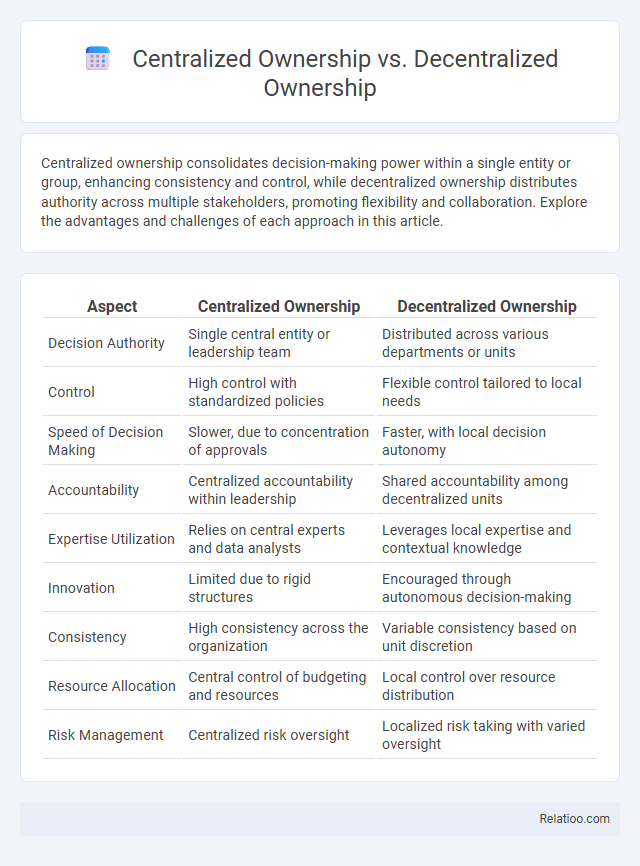Centralized ownership consolidates decision-making power within a single entity or group, enhancing consistency and control, while decentralized ownership distributes authority across multiple stakeholders, promoting flexibility and collaboration. Explore the advantages and challenges of each approach in this article.
Table of Comparison
| Aspect | Centralized Ownership | Decentralized Ownership |
|---|---|---|
| Decision Authority | Single central entity or leadership team | Distributed across various departments or units |
| Control | High control with standardized policies | Flexible control tailored to local needs |
| Speed of Decision Making | Slower, due to concentration of approvals | Faster, with local decision autonomy |
| Accountability | Centralized accountability within leadership | Shared accountability among decentralized units |
| Expertise Utilization | Relies on central experts and data analysts | Leverages local expertise and contextual knowledge |
| Innovation | Limited due to rigid structures | Encouraged through autonomous decision-making |
| Consistency | High consistency across the organization | Variable consistency based on unit discretion |
| Resource Allocation | Central control of budgeting and resources | Local control over resource distribution |
| Risk Management | Centralized risk oversight | Localized risk taking with varied oversight |
Understanding Centralized Ownership
Centralized ownership consolidates control and decision-making authority within a single entity or a small group, enabling streamlined management and consistent policies. This structure contrasts with decentralized ownership, where control is distributed across multiple stakeholders, fostering flexibility and localized decision-making. Understanding how centralized ownership impacts your organization's efficiency, accountability, and strategic alignment is crucial for optimizing governance and operational effectiveness.
What is Decentralized Ownership?
Decentralized ownership distributes control and decision-making authority across multiple stakeholders rather than consolidating it in a single entity, enhancing transparency and reducing risks associated with central points of failure. This structure empowers you to participate directly in governance, fostering more democratic and resilient systems, especially in blockchain networks or cooperative organizations. Compared to centralized ownership, decentralized models promote collaboration, security, and equitable resource management by leveraging diverse inputs and consensus mechanisms.
Key Differences Between Centralized and Decentralized Ownership
Centralized ownership consolidates decision-making power and control within a single entity or a small group, leading to unified strategies and quicker execution but potential bottlenecks. Decentralized ownership distributes authority across multiple stakeholders or units, promoting flexibility, local responsiveness, and innovation at the expense of coordination challenges and slower overall decision-making. Key differences include control concentration, risk distribution, and agility, with centralized models prioritizing uniformity and decentralized models emphasizing autonomy and diverse input.
Advantages of Centralized Ownership
Centralized ownership streamlines decision-making processes by consolidating control within a single authority, enhancing consistency and alignment with organizational goals. This structure reduces redundancy and optimizes resource allocation, resulting in improved efficiency and faster response times. Centralized ownership also strengthens accountability and governance, facilitating clearer strategic direction and risk management.
Benefits of Decentralized Ownership
Decentralized ownership distributes control among multiple stakeholders, enhancing transparency and reducing risks associated with single-point failures common in centralized ownership. Your involvement benefits from increased innovation and faster decision-making as decentralized models foster collaboration and adaptability. Ownership structures vary, but decentralization improves resilience and aligns incentives across diverse participants, driving sustainable growth.
Common Challenges in Centralized Ownership Models
Centralized ownership models often face challenges such as limited decision-making agility, bottlenecks due to concentration of authority, and reduced innovation from overly rigid control structures. These issues can lead to slower response times in dynamic markets and decreased employee empowerment, negatively impacting overall organizational performance. In contrast, decentralized ownership mitigates these problems by distributing authority and encouraging autonomy, enhancing flexibility and innovation.
Drawbacks of Decentralized Ownership Structures
Decentralized ownership structures often face drawbacks such as coordination challenges due to dispersed decision-making authority, leading to inefficiencies and slower response times. The lack of a unified control can result in inconsistent strategic direction and difficulties in enforcing accountability across diverse units. In contrast, centralized ownership concentrates authority and streamlines decision-making but may sacrifice flexibility and local responsiveness critical in dynamic markets.
Impact on Decision-Making Processes
Centralized ownership consolidates decision-making authority within a core group or individual, enabling faster, more consistent choices but potentially limiting diverse input and flexibility. Decentralized ownership distributes decision rights across multiple stakeholders, fostering innovation and responsiveness at the expense of slower consensus-building and possible conflicts. Understanding the impact on decision-making processes is crucial for organizations aiming to balance control, agility, and inclusiveness in strategic execution.
Security and Trust Considerations
Centralized ownership often provides streamlined security through unified control, but it can create single points of failure and increase vulnerability to insider threats. Decentralized ownership enhances trust by distributing control among multiple parties, reducing the risk of manipulation or data breaches, yet it may introduce challenges in achieving consistent security protocols. Understanding how your ownership structure impacts security and trust is crucial for implementing robust safeguards and maintaining stakeholder confidence.
Choosing the Right Ownership Model for Your Organization
Choosing the right ownership model for your organization hinges on factors like control, decision-making speed, and operational complexity. Centralized ownership offers streamlined governance and unified strategic direction, while decentralized ownership empowers individual units with autonomy and quicker response times to local challenges. Analyzing your organization's size, industry dynamics, and long-term goals ensures the selected ownership structure aligns with sustainable growth and effective resource management.

Infographic: Centralized Ownership vs Decentralized Ownership
 relatioo.com
relatioo.com